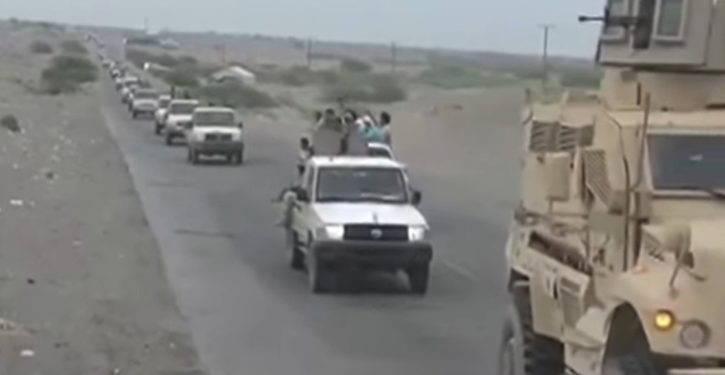
Call it a proxy war if you like, between Iran and Saudi Arabia. That characterization may shortchange the internal divisions in Yemen, which has never really functioned as a unified political entity. But it does highlight an important reality – in particular, the reality that is driving the interventions in Yemen by Iran and a Saudi-led coalition.
Who controls Yemen is geopolitically crucial. It’s about domination of the chokepoint gauntlet from the Suez Canal to the Bab-el-Mandeb Strait, the Gulf of Aden, and the Indian Ocean that lies to the east.
In the post-Pax Americana world we have inhabited since 2011, control of maritime chokepoints has shifted from the implied guarantees of American maritime power to the offshore power projection capabilities of littoral nations.
Will this presidential election be the most important in American history?
The observance of international conventions in chokepoints – like the Bab-el-Mandeb Strait – was largely a given in the Pax Americana decades, rarely requiring enforcement with urgent diplomacy (or hot lead). Threats and instability certainly broke out (e.g., in the Strait of Hormuz in the 1980s). But a world organized essentially into blocs tended to fall in line with the pragmatic arrangements of the bloc leaders, which from 1945 until about 15-20 years ago were the U.S. alliance network and the Russian alliance network.
The Cold War stasis
The Horn of Africa and the Arabian Peninsula were considered vital territory by both networks. But geography, military technology, and the political styles of the superpowers combined to impose a tense but rarely-broken stasis on the region. The U.S. emphasized maritime dominance and the guarantee of our principles of freedom of the seas and freedom of trade. Certainly we cultivated local client relationships with governments (notably with Saudi Arabia, Jordan, the Persian Gulf nations, and Israel), but it was not in our aspirations or political style to embed with armed insurgencies in the regional nations, seeking to gain footholds in territory that way.
The former Soviet Union, on the other hand, adopted the style early in its existence of cultivating ties to internal factions and insurgencies abroad, and used it throughout the region, including at various times Somalia, Ethiopia, Sudan, Egypt, and what was at one time South Yemen (on a map, eastern Yemen. “North Yemen,” or western Yemen, was more Western-friendly). The Soviets lacked the seapower to enforce comprehensive maritime conventions, and they pursued their ideological goals by different methods.
Each superpower tried to set a watch against the activities of the other as best it could. The U.S. method was to work through client governments and use aid, commerce, and intelligence to counter Soviet activities. The Soviet armed forces maintained a military presence where they could (e.g., a naval anchorage at Socotra Island off Yemen, along with reconnaissance aircraft), as a marker and deterrent if not a robust, operationally effective match for American capabilities.

The Soviet ideological model of fomenting revolution was always pushing to some extent against the status quo. But ultimately, the stasis was largely accepted by both sides: a de facto condition, as opposed to a desired one, since overt breaches of it would bring too high a cost.
The methods and postures that evolved over time came to function as guarantees for the regional nations. The superpower arrangements set a boundary of deterrence on local or third-party hopes of upsetting the status quo.
When the end of the Pax Americana became crystal clear, by March of 2011 as an inert, nearly silent United States spoke randomly of “leading from behind” in Libya, Iran began to redouble the efforts she already had underway with the Houthi insurgency in Yemen. If America was no longer prepared to take the lead in bolstering the status quo, all bets were off. Strategic chokepoints were fair game. And Iran had in any case been eyeing them for some time already.
Post-Pax Americana
Since at least 2009, Iran has been arming the Houthis with the purpose of gaining influence, and ultimately dominance, in the Suez-to-Gulf of Aden belt. Iran doesn’t need to rule the nearby territory; the mullahs just need a quiescent client there, one who will let them station military forces like drone squadrons, missile batteries, and armed mini-subs.
This is what the Saudis can’t tolerate. The Saudis’ Gulf allies – the UAE in particular – don’t like it either. Nor does Sudan, which in the last several years has made a major shift from her notable friendliness with Iran a decade ago, to now joining forces with Saudi Arabia in the fight to roll back the Houthis in Yemen.
I’ve written before about the scope of the regional competition between Tehran and Riyadh. Its origins go back many centuries, to before the rise of Islam (and before Tehran and Riyadh, the cities, were nationally or even culturally representative). There’s too much history for a convenient detour here. But once the clamps of the old Pax Americana were well and truly lifted, that competition accelerated and came to the fore. It was bound to. That’s what the collapse of hegemonic domination does: unleash more-localized conflicts.
The map below is reused from a post in 2015 depicting Iran’s growing effort to flank the territory to her south and west, and how that affected the calculations of ISIS. It obviously applies to the strategic concerns of Saudi Arabia, Jordan, and Egypt as well. Note: since 2015, Sudan’s affinity has shifted to the Saudi-led coalition.

It’s essential to understand that that is what is going on now. Much of the coverage by Western media is written as if there is no map and no history, and everything is about factional political propaganda and who has the most evil behavior in military operations.
The more explanatory and predictive assessment, however, is that Iran, currently an ideologically disruptive power, is seizing opportunities created by the collapse of the Pax Americana, and Saudi Arabia, long a status quo power, is pushing back – and doing so, because the Pax is gone, in her own right, and with her own agenda.
Along those lines, another essential point is that the new military and strategic energy from Saudi Arabia is a direct result of the internal reordering done by Prince Mohammad bin Salman (“MBS”) in the last seven months. In particular, the military activism we’re seeing from Saudi Arabia is the product of his little-remarked but extremely important resubordination of the armed forces.
Iran and Saudi Arabia turn both lights green at the intersection
What that resubordination did – I wrote about it here at the time – was place in different hands the political decision to mount power-projection operations outside the Saudis’ immediate territory. MBS forced this new arrangement shortly after Iran made a similar move to resubordinate military forces.
In both cases, the “problem” was the inconvenient political obstacles to making decisions about using force for power projection abroad. The subordination of the armed forces was originally designed to bake those obstacles into such decisions (largely to pacify the concerns of domestic factions), and thus to make the decisions less likely, or at least harder to agree on.
What changed was, thus, the political ease of making decisions to use force abroad. It’s now more unified and streamlined in both nations: in Iran, consolidated under the ayatollah – the clerical regime leader – and his favorite IRGC military leaders (e.g., Qassem Soleimani); and in Saudi Arabia, mainly in the hands of MBS – as long as he doesn’t screw up.
That’s a key factor in the recently increased determination and relentlessness of Iran’s attempts to move conventional military equipment into Syria. But it’s equally significant to Saudi Arabia’s planning, mounting, and spearheading of a military campaign to retake Yemen from the Houthis. In the military-activism profiles of both nations, the old “governor” of internal, institutional resistance and dithering is off.
In my view, Iran has turned out to actually be more limited in what she can do, because of her domestic unrest problem. The Saudi rulers aren’t facing anything on that level, and in any case have the political advantage of the Saudi public largely seeing the fight in Yemen as a defensive one. As long as the Houthis keep lobbing missiles into Saudi Arabia, that advantage will continue. But in Iran, an increasingly disgruntled people has been objecting very specifically and vocally to military deployments abroad, seeing them as a costly and inexcusable burden on Iranians.
And it’s back to the future in Yemen
This is the context in which to understand the assault launched this week by the Saudi-led coalition on the Yemeni port city of Hodeidah, on the Red Sea (see here as well). The coalition, backing the Yemeni forces loyal to the government of Abdrabbuh Mansoor Hadi, has been making headway near the Houthi-dominated capital city of Sanaa, in the country’s west, and is now seeking to gain control of Hodeidah to prevent Houthi import of arms through the port.

If the coalition controls the port, it can cut off the Houthis inland from that major source of outside supply. A contingent of UAE troops is on the ground in Yemen, driving up the coast toward Hodeidah from the port city of Aden, where the (recognized) Hadi government has been nominally operating. The UAE also has warships (probably frigates) offshore, which readers may have seen were under attack from antiship missiles near Hodeidah this week. If we can believe Houthi reporting, one UAE warship was struck and actually sunk by an antiship missile early on Wednesday.
The Saudis are providing air support to this operation. It is not clear if there are Saudi naval ships involved, but there probably are.
Meanwhile, the overall situation in Yemen has undergone something of a strategic change, because the postures of the regional powers have materially shifted. I wrote some months ago about reports that the Saudis had quietly deployed some ground forces into Yemen’s eastern Al-Mahra province. That alone – some of the earliest evidence of MBS’s power-projection intentions – accelerates a lurking reality that the Houthis will soon be, if they are not now, strategically surrounded.
But an equally significant shift has occurred just offshore, on the aforementioned Yemeni island of Socotra. Socotra was the haunt of the former-Soviet navy during the Cold War, but after the collapse of the Soviet Union at the end of 1991 was no longer used for a forward naval presence by Russia.
In the spring of 2018, however, Socotra has been back in the military-hosting business. But this time, the “guest” is the UAE. The Emirati forces operating in and around Yemen need a fortified logistics hub, and Socotra is the obvious place. It’s also some very nice real estate for gaining leverage in the regional power competition, and it’s a good bet the UAE doesn’t plan to pull back out any time soon.
The recognized Hadi government of Yemen isn’t too happy about UAE forces basically occupying Socotra. But the Emirati presence is the price Hadi and his supporters are having to pay for UAE military help. There’s a complicating factor as well, since Socotra has a separatist faction that welcomes the armed Emirati descent on the island.
The Saudis, meanwhile, have a hand in the militarization of Socotra. They dispatched troops to the island in mid-May, nominally to help train a Yemeni force there. In Al-Mahra, the UAE has also reportedly been involved in keeping the ports closed to arms carriers – e.g., coastal freighters and even dhows – bearing cargo wending its way from Iran.
All the activity on Socotra has excited the concern of Oman, moreover, and Oman is also disquieted by the arrival of the Saudis and Emiratis in and near Al-Mahra – the parent province (or governorate) of Socotra. So Oman has yet a third vision for Socotra, involving Oman’s favored political leader in Al-Mahra – whose ultimate loyalty to the Hadi government is by no means assured.
In all of this, the ideological catalyst – the chord to which 20th-century sensibilities vibrate – is Iran’s revolutionary vision for disruption of the status quo and a wholesale reordering of it.
The rest of the dynamic movement is much better explained by geography, history, and the recurring patterns of human nature. Given the opportunity forced by Iran’s activism, and given the lack of boundaries for their vision – now that there’s no Pax Americana to set them – the other regional nations are rethinking the outlines of their national interests, whether for security or economics.
The spectacle of circumspect, adventure-resistant Saudi Arabia and the UAE depositing troops on the far side of the Arabian Peninsula, and doing that as a pragmatic move, may not be your father’s geopolitics.
But it was your father’s great-grandfather’s geopolitics. Plus or minus some technological conditions, it’s very much what that august ancestor’s geopolitics looked like.




